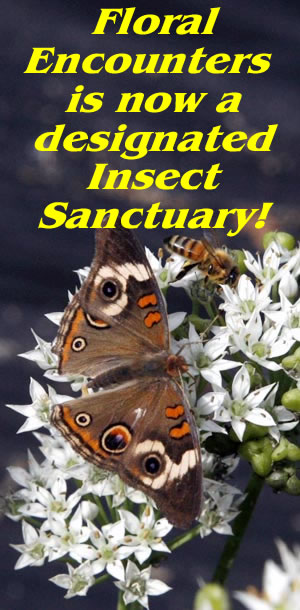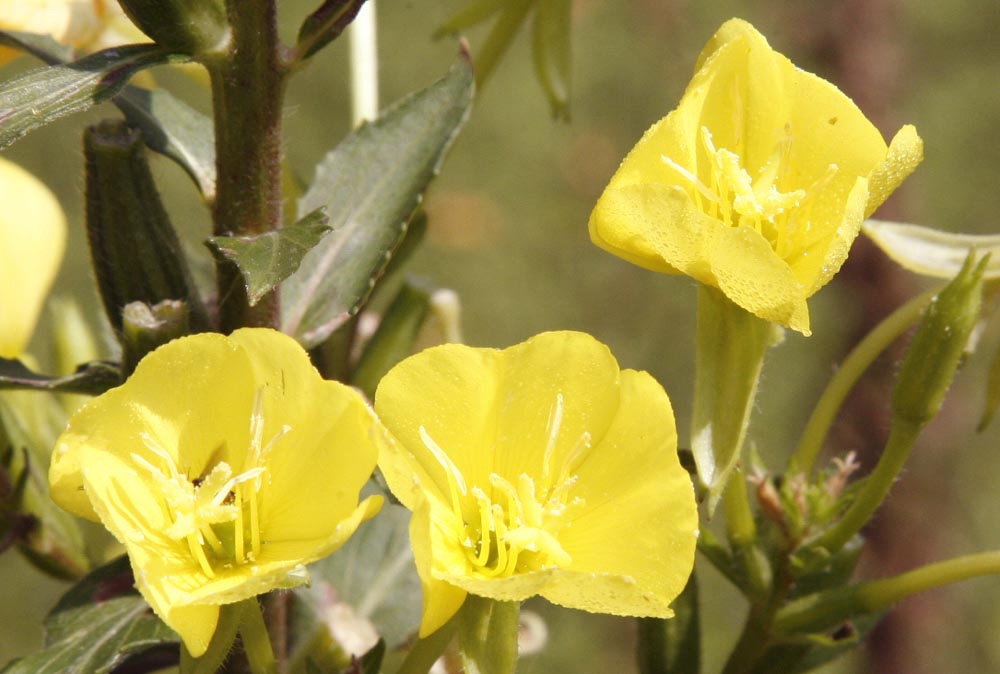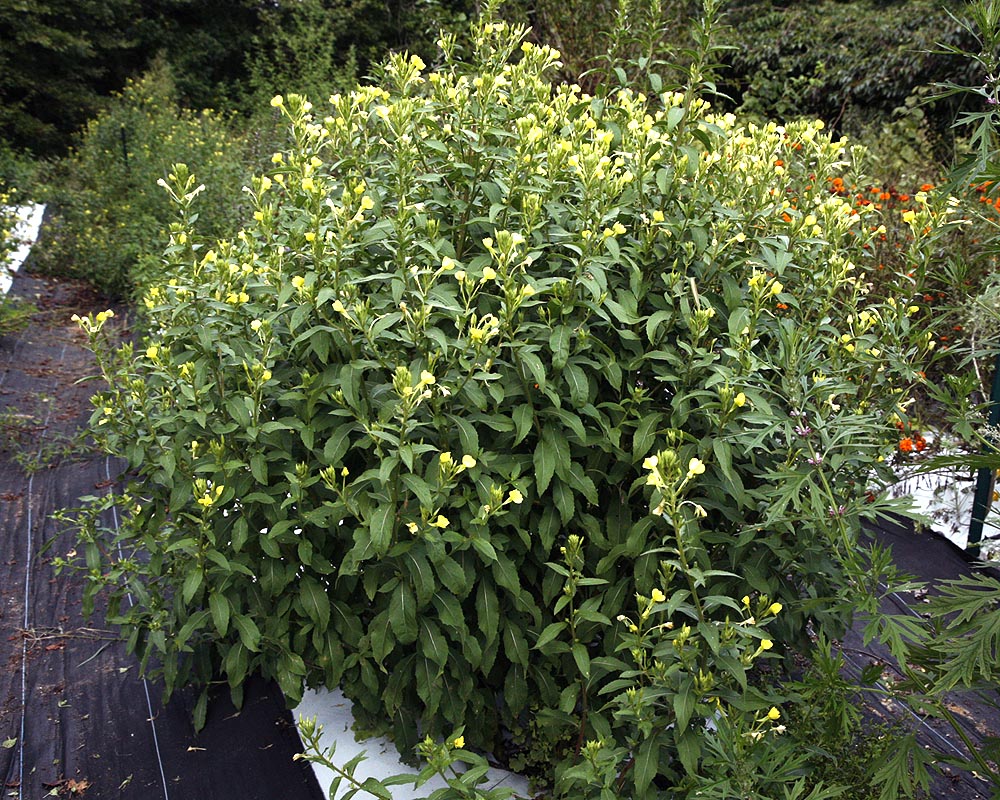A bright colorful native biennial that needs almost not care and will grow in poor soil in bright sunshine. Growing to as much as 7 feet in height and hardy to zone 3 it produces bright yellow flowers from an open bush like plant from early summer until fall. Ideal for sunny dry areas and very drought tolerant. Deer don't seem to eat it neither do the rabbits. Butterflies love the flowers.
Description
A Native biennial plant that can reach 7' in height. During the first year it
produces a small rosette of leaves that are flat to the ground and can go unnoticed.
In late spring the second year it sends up a tall stiff central stem which is
usually much branched creating a open bush like appearance. The stems are light
green or red and covered in stiff white hairs making them slightly prickly.
The leaves are olive green and are spear shaped (lanceolate) with mostly smooth
margins and are nearly hairless. The are most commonly 4" - 6' long and
1" wide but can reach 8" long and 2" wide. Leaves tend to reduce
in size as the ascend the stems with bunches of smaller secondary leaves at
the tops (apex) of the stalks. The flowers are produces along most of the upper
portion of the stem blooming towards the top. They are bright yellow, about
1" across with four petals and prominent stamens and a long green stalk
of calyx. They remain open from early evening until early morning but often
stay open longer or cloudy or cooler days and have a pleasant lemon like scent.
They are produced prolifically along the stems from mid summer until fall giving
a long blooming time. The flowers are followed by long narrow seed pods. stem
Location and care
Hardy plant that does best on poor soils provided they are well drained. Since
it produces a tap root it cannot tolerate wet soils or those that become wet
during the winter as it will rot the roots. It does best in sandy soil but will
tolerate almost anything that is not wet. Prefers full sun but will grow well
in areas where it can get sun part of the day. It will not grow well in areas
that do not receive at least some full sun during the day. Once established
the plants are extremely drought resistant and will continue to flower during
hot dry periods, however during prolonged drought the lower leaves are likely
to turn yellow and drop off while upper leaves may develop slightly brown margins.
Since plants will grow to 7 feet tall pick an area where height is needed or
not a problem. Excellent for meadow areas or sections away from the house but
visible. No care or maintenance is needed once plants are growing just cut down
the stems at the end of the flowering period. Plant may reseed themselves but
need to be in areas where they are not disturbed to develop for the following
year. If intending to allow reseeding be aware of the rosettes and don't weed
out. If mowing keep blade high to miss the low growing rosette.
Growing
In meadow like conditions or open areas seeds can be sown in situ in late spring
to early summer for flowering the following year. Seeds need light to germinate
so don't scatter seed in high growing meadow or area where the sun does not
reach bare soil or seeds will not germinate.
Can be sown indoors for more control. Sow late winter in flats, or plug cells
Do not cover seed. Keep compost moist until germination occurs most commonly
within 15-30 days at 18-21°C (65-70°F). If there is no germination at
the end of this period move trays to a cold area about 4°C (39ºF) for
4 wks, for 7 to 28 days. All our seed has been pre stratified so this step should
not be necessary in most cases.
Transplant to individual pots when seedlings are large enough to handle and
plant outside when rosettes are at least 3" across.
If planting in full
sun area pick a cloudy day so plants have time to adjust to their new surroundings
before the full sun hits them. Space plants at least 14" apart. Water in
well until plants have established then they can be ignored.
Edible Uses
The fleshy first year taproot can be dug up, cooked and eaten, but boiling and
eating like salsify. Those who eat it claim it is fleshy, sweet and succulent
with a slightly peppery taste. The flowers can be used in salads and as a garnish
and are sweet and interesting. The seeds are also edible and a excellent source
of gamma-linolenic acid, however the seeds are small and difficult to harvest
making yields low and oil production expensive.
Medicinal Uses
A very useful medicinal plant. The bark and the leaves are used as a sedative
and are used for treating gastro-intestinal disorders, whooping cough and asthma.
A syrup made from the flowers is also an effective treatment for whooping cough.
The seed oil containing gamma-linolenic acid, has many uses including treatment
for eczema, acne, brittle nails, rheumatoid arthritis and alcohol-related liver
damage. reduce blood cholesterol levels and lower the blood pressure. It may
also have uses for multiple sclerosis, pre-menstrual tension and hyperactivity.
The poulticed root is applied to piles and bruises. A tea made from the roots
is used in the treatment of obesity and bowel pains
Caution. Using this plant can reduce the threshold for epileptic fits and should be used with care in those taking anticoagulants. Adverse effects: may cause headaches and nausea on an empty stomach. Diarrhea with high doses.
Other Uses
The oil from the seed is added to skin preparations and cosmetics. It is often
combined with vitamin E to prevent oxidation. A yellow dye is obtained from
the flowers. A finely ground powder made from the flowering stems is used cosmetically
in face-masks to counteract reddened skins.
Other names.
King's cure-all, Common Evening Primrose, Esekotu, Great Evening Primrose, King's-cureall,
Middelste Teunisbloem, Onagra biennis, Brunyera biennis, Oenothera muricata,
Onagra muricata, Sun Drop








